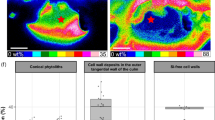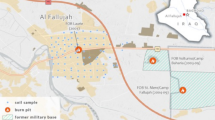Abstract
Mosses can be used as biomonitors to monitor radionuclide deposition and heavy metal pollution in cities, forests, and grasslands. The aims of this work were to determine the activity concentrations of natural (210Po, 210Pb or 210Pbex (excess 210Pb is defined as the activity of 210Pb minus the activity of 226Ra), 7Be, 40K, 226Ra, 238U, and 232Th) and anthropogenic radionuclides (137Cs) in moss body profiles and in situ underlying soils of moss samples and to assess/determine the distribution features and accumulation of these radionuclides. Activity concentrations of radionuclides in the samples were measured using a low-background gamma spectrometer and a low-background alpha spectrometer. Consistent with their source, the studied radionuclides in the moss samples and underlying soils were divided according to the principal component analysis (PCA) results into an airborne group (210Po, 210Pb (210Pbex), 7Be, and 137Cs) and a terrestrial group (40K, 238U, 226Ra, and 232Th). The activity concentrations of 210Po and 210Pbex in moss body profiles were mainly concentrated in the stems–rhizoid parts, in which we measured some of the highest 210Po and 210Pbex levels compared to the results in the literature. 7Be mainly accumulated in the leaves–stem parts. Different positive correlations were observed between 210Po and 210Pb and between 7Be and 210Pb, which indicated that the uptake mechanisms of 210Po, 210Pb, and 7Be by moss plants were different, to some extent. 137Cs was detected only in some moss samples, and the fraction of 137Cs in the underlying soils was much lower than that in the moss, suggesting that mosses were protecting the underlying soils from further pollution. Except for 40K, the terrestrial radionuclide (238U, 226Ra, and 232Th) content in mosses was predominantly at low levels, which indicated not only the inability of mosses to use those elements for metabolic purposes but also the rather poor capability of mosses to directly mobilize, absorb, and transport elements (U, Ra, or Th) not dissolved in water.



Similar content being viewed by others
References
Aarkrog A, Dahlgaard H, Holm E, Hallstadius L (1984) Evidence for bismuth-207 in global fallout. J Environ Radioact 1:107–117
Aleksiayenak YV, Frontasyeva MV, Florek M, Sykora I, Holy K, Masarik J, Brestakova L, Jeskovsky M, Steinnes E, Faanhof A, Ramatlhape KI (2013) Distributions of 137Cs and 210Pb in moss collected from Belarus and Slovakia. J Environ Radioact 117:19–24
Al-Masri MS, Mamish S, Al-Haleem MA, Al-Shamali K (2005) Lycopodium cernuum and Funaria hygrometrica as deposition indicators for radionuclides and trace metals. J Radioanal Nucl Chem 266:49–55
Bakar NSA, Mahmood ZUYW, Saat A, Ishak AK (2014) Anthropogenic airborne depositions of Po-210, Pb-210 and Po-210/Pb-210 in the mosses and surface soils at the vicinity of a coal-fired power. J Sains Nukl Malays 26(1):9–17
Baskaran M (2011) Po-210 and Pb-210 as atmospheric tracers and global atmospheric Pb-210 fallout: a review. J Environ Radioact 102:500–513
Belivermiş M, Kılıç Ö, Çayır A, Coşkun M, Coşkun M (2016) Assessment of 210Po and 210Pb in lichen, moss and soil around Çan coal-fired power plant, Turkey. J Radioanal Nucl Chem 307:523–531
Betsou C, Tsakiri E, Kazakis N, Hansman J, Krmar M, Frontasyeva M, Ioannidou A (2018) Heavy metals and radioactive nuclide concentrations in mosses in Greece. Radiat Eff Defects Solids 173(9–10):851–856
Boryło A, Olszewski G, Skwarzec B (2013) A study on lead (210Pb) and polonium (210Po) contamination from phosphogypsum in the environment of Wiślinka (northern Poland). Environ Sci Processes Impacts 15(8):1622–1628
Boryło A, Romańczyk G, Skwarzec B (2017) Lichens and mosses as polonium and uranium biomonitors on Sobieszewo Island. J Radioanal Nucl Chem 311:859–869
Burger A, Lichtscheidl I (2018) Stable and radioactive cesium: a review about distribution in the environment, uptake and translocation in plants, plant reactions and plants' potential for bioremediation. Sci Total Environ 618:1459–1485
Celik N, Cevik U, Celik A, Koz B (2009) Natural and artificial radioactivity measurements in eastern Black Sea region of Turkey. J Hazard Mater 162:146–153
Chen J, Luo S, Huang Y (2016) Scavenging and fractionation of particle-reactive radioisotopes 7Be, 210Pb and 210Po in the atmosphere. Geochim Cosmochim Acta 188:208–223
Delfanti R, Papucci C, Benco C (1999) Mosses as indicators of radioactivity deposition around a coal-fired power station. Sci Total Environ 227:49–56
Demková L, Bobul’ská L, Árvay J, Jezný T, Ducsay L (2017) Biomonitoring of heavy metals contamination by mosses and lichens around Slovinky tailing pond (Slovakia). J Environ Sci Health A Toxic/Hazard Subst Environ Eng 52(1):30–36
Długosz-Lisiecka M (2017) Kinetics of 210Po accumulation in moss body profiles. Environ Sci Pollut Res 24(25):20254–20260
Długosz-Lisiecka M, Wróbel J (2014) Use of moss and lichen species to identify 210Po-contaminated regions. Environ Sci Processes Impacts 16(12):2729–2733
Dowdall M, Gwynn JP, Moran C, O'Dea J, Davids C, Lind B (2005) Uptake of radionuclides by vegetation at a high Arctic location. Environ Pollut 133:327–332
Dragović S, Mihailović N, Gajić B (2010) Quantification of transfer of 238U, 226Ra, 232Th, 40K and 137Cs in mosses of a semi-natural ecosystem. J Environ Radioact 101:159–164
Du J, Du J, Baskaran M, Bi Q, Huang D, Jiang Y (2015) Temporal variations of atmospheric depositional fluxes of 7Be and 210Pb over 8 years (2006–2013) at Shanghai, China, and synthesis of global fallout data. J Geophys Res Atmos 120:4323–4339
Eckl P, Hofmann W, Tüurk R (1986) Uptake of natural and man-made radionuclides by lichens and mushrooms. Radiat Environ Biophys 25:43–54
Galhardi JA, García-Tenorio R, Díaz Francés I, Bonotto DM, Marcelli MP (2017) Natural radionuclides in lichens, mosses and ferns in a thermal power plant and in an adjacent coal mine area in southern Brazil. J Environ Radioact 167:43–53
Geffert JL, Frahm JP, Barthlott W, Mutke J (2013) Global moss diversity: spatial and taxonomic patterns of species richness. J Bryol 35(1):1–11
Godoy JM, Schuch LA, Nordemann DJR, Reis VRG, Ramalho M, Recio JC, Brito RRA, Olech MA (1998) 137Cs, 226, 228Ra, 210Pb and 40K concentrations in Antarctic soil, sediment and selected moss and lichen samples. J Environ Radioact 41:33–45
Gordo E, Dueñas C, Fernández MC, Liger E, Cañete S (2015) Behavior of ambient concentrations of natural radionuclides 7Be, 210Pb, 40K in the Mediterranean coastal city of Málaga (Spain). Environ Sci Pollut Res 22:7653–7664
Hu QH, Weng JQ, Wang JS (2010) Sources of anthropogenic radionuclides in the environment: a review. J Environ Radioact 101(6):426–437
Kamar M, Radnović D, Hansman J, Repić P (2017) Influence of broadleaf forest vegetation on atmospheric deposition of airborne radionuclides. J Environ Radioact 177:32–36
Karunakara N, Avadhani DN, Mahesh HM, Somashekarappa HM, Narayana Y, Siddappa K (2000) Distribution and enrichment of 210Po in the environment of Kaiga in South India. J Environ Radioact 51(3):349–362
Karunakara N, Somashekarappa HM, Narayana Y, Avadhani DN, Mahesh HM, Siddappa K (2003) 226Ra, 40K and 7Be activity concentrations in plants in the environment of Kaiga, India. J Environ Radioact 65:255–266
Kershaw P, Baxter A (1995) The transfer of reprocessing wastes from north-west Europe to the Arctic. Deep Sea Res Part II 42(6):1413–1448
Krmar M, Radnović D, Rakic S, Matavuly M (2007) Possible use of terrestrial mosses in detection of atmospheric deposition of 7Be over large areas. J Environ Radioact 95(1):53–61
Krmar M, Wattanavatee K, Radnović D, Slivka J, Bhongsuwan T, Frontasyeva MV, Pavlov SS (2013) Airborne radionuclides in mosses collected at different latitudes. J Environ Radioact 117:45–48
Krmar M, Mihailović DT, Arsenić I, Radnović D, Pap I (2016) Beryllium-7 and 210Pb atmospheric deposition measured in moss and dependence on cumulative precipitation. Sci Total Environ 541:941–948
Lal D, Malhotra PK, Peters B (1958) On the production of radioisotopes in the atmosphere by cosmic radiation and their application to meteorology. J Atmos Terr Phys 12:306–328
Li P, Sun X, Cheng J, Zheng G (2019) Absorption of the natural radioactive gas 222Rn and its progeny 210Pb by Spanish moss Tillandsia usneoides and its response to radiation. Environ Exp Bot 158:22–27
Martínez-Aguirre A, García-León M, Gascó C, Travesi A (1996) Anthropogenic emissions of 210Po, 210Pb and 226Ra in an estuarine environment. J Radioanal Nucl Chem 207(2):357–367
Mitrović B, Ajtić J, Lazić M, Andrić V, Krstić N, Vranješ B, Vićentijević M (2016) Natural and anthropogenic radioactivity in the environment of Kopaonik mountain, Serbia. Environ Pollut 215:273–279
Oguri E, Deguchi H (2018) Radiocesium contamination of the moss Hypnum plumaeforme caused by the Fukushima Dai-ichi Nuclear Power Plant accident. J Environ Radioact 192:648–653
Persson BRR, Holm E (2011) Polonium-210 and lead-210 in the terrestrial environment: a historical review. J Environ Radioact 102:420–429
Pettersson HBL, Hallstadius L, Redvall R, Holm E (1988) Radioecology in the vicinity of prospected uranium mining sites in a subarctic environment. J Environ Radioact 6:25–40
Ross EM, Wesley SG (2011) 210Po in epiphytic lichens of peninsular India. Curr Sci 100(2):163–164
Sert E, Uğur A, Özden B, Saç MM, Camgöz B (2011) Biomonitoring of 210Po and 210Pb using lichens and mosses around coal-fired power plants in western Turkey. J Environ Radioact 102:535–542
Steinhauser G, Brandl A, Johnson TE (2014) Comparison of the Chernobyl and Fukushima nuclear accidents: a review of the environmental impacts. Sci Total Environ 470:800–817
Sumerling TJ (1984) The use of mosses as indicators of airborne radionuclides near a major nuclear installation. Sci Total Environ 35:251–265
Szymańska K, Falandysz J, Skwarzec B, Strumińska-Parulska D (2018) 210Po and 210Pb in forest mushrooms of genus Leccinum and topsoil from northern Poland and its contribution to the radiation dose. Chemosphere 213:133–140
Tsikritzis LI (2005) Chemometrics of the distribution and origin of 226Ra, 228Ra, 40K and 137Cs in plants near the West Macedonia Lignite Center (Greece). J Radioanal Nucl Chem 264:651–656
Uğur A, Özden B, Saç MM, Yener G (2003) Biomonitoring of 210Po and 210Pb using lichens and mosses around a uraniferous coal-fired power plant in western Turkey. Atmos Environ 37:2237–2245
Uğur A, Özden B, Yener G, Saç MM, Kurucu Y, Altınbaş Ü, Bolca M (2009) Distributions of 210Pb around a uraniferous coal-fired power plant in western Turkey. Environ Monit Assess 149(1–4):195–200
UNSCEAR (2000) Sources and effects of ionizing radiation. Report of the United Nations Scientific Committee on the effects of atomic radiation to the General Assembly. United Nations, New York
Wattanavatee K, Krmar M, Bhongsuwan T (2017) A survey of natural terrestrial and airborne radionuclides in moss samples from the peninsular Thailand. J Environ Radioact 177:113–127
Wu F, Zheng J, Liao H, Yamada M, Wan G (2011) Anomalous plutonium isotopic ratios in sediments of Lake Qinghai from the Qinghai-Tibetan Plateau, China. Environ Sci Technol 45:9188–9194
Zeng Y, Zhang X, Zhou W, Qi Y (2007) On the source of radioisotope 137Cs in the surface sediments of Lake Qinghai. J Lake Sci 19:516–521 (in Chinese with English abstract)
Acknowledgments
We are grateful to Dr. Ruiliang Zhu, School of Life Science, East China Normal University, for his advice and guidance in moss species identification. We would like to thank the group members of the RIC team in East China Normal University for their help in sampling. We would also like to thank the in-depth reviews of two anonymous reviewers.
Funding
This study was partly supported by the Natural Science Foundation of China (grants 41576083, 41706089, and 41706083).
Author information
Authors and Affiliations
Corresponding author
Additional information
Responsible editor: Georg Steinhauser
Publisher’s note
Springer Nature remains neutral with regard to jurisdictional claims in published maps and institutional affiliations.
Highlights
1. 210Po, 210Pb, 7Be, 137Cs, 40K, 226Ra, 238U, and 232Th activity concentrations in vertical moss profiles were measured.
2. PCA distinguished these radionuclides into airborne and terrestrial sources.
3. Extremely high levels of 210Po and 210Pb and the deficiency of 210Po relative to 210Pb were observed in moss bodies.
4. 7Be almost exclusively accumulated in the leaves–stem tissues of all moss samples.
5. Mosses taken from Svalbard showed very high 137Cs levels, indicating that mosses may accumulate 137Cs and protect soils from further pollution.
6. Low accumulation of terrestrial radionuclides (238U, 226Ra, and 232Th) was found in mosses, suggesting the inefficient uptake mechanisms of moss plants and their inability to use these elements.
Rights and permissions
About this article
Cite this article
Zhong, Q., Du, J., Puigcorbé, V. et al. Accumulation of natural and anthropogenic radionuclides in body profiles of Bryidae, a subgroup of mosses. Environ Sci Pollut Res 26, 27872–27887 (2019). https://doi.org/10.1007/s11356-019-05993-3
Received:
Accepted:
Published:
Issue Date:
DOI: https://doi.org/10.1007/s11356-019-05993-3




